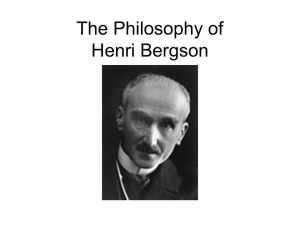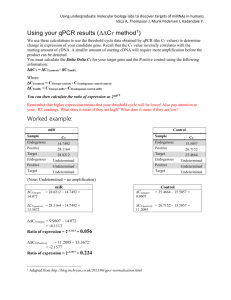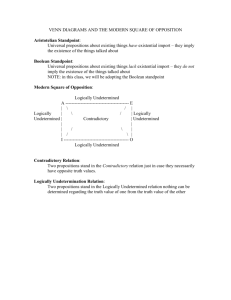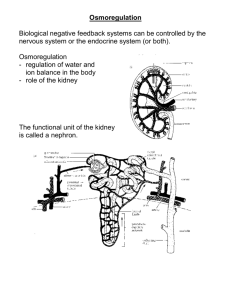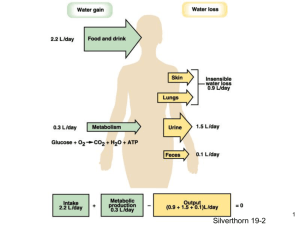093008.mheung.physwatermetab.osmoregulation
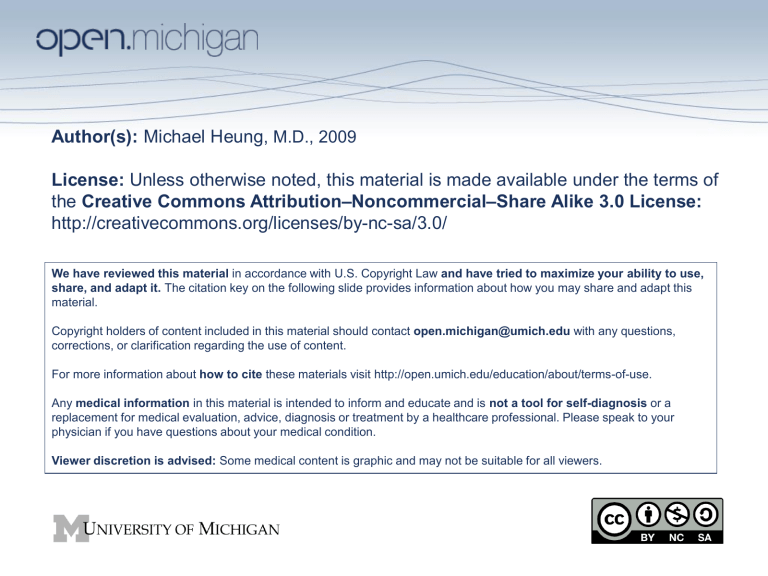
Author(s): Michael Heung , M.D., 2009
License: Unless otherwise noted, this material is made available under the terms of the Creative Commons Attribution –Noncommercial–Share Alike 3.0 License: http://creativecommons.org/licenses/by-nc-sa/3.0/
We have reviewed this material in accordance with U.S. Copyright Law and have tried to maximize your ability to use, share, and adapt it. The citation key on the following slide provides information about how you may share and adapt this material.
Copyright holders of content included in this material should contact open.michigan@umich.edu with any questions, corrections, or clarification regarding the use of content.
For more information about how to cite these materials visit http://open.umich.edu/education/about/terms-of-use.
Any medical information in this material is intended to inform and educate and is not a tool for self-diagnosis or a replacement for medical evaluation, advice, diagnosis or treatment by a healthcare professional. Please speak to your physician if you have questions about your medical condition.
Viewer discretion is advised: Some medical content is graphic and may not be suitable for all viewers.
Citation Key for more information see: http://open.umich.edu/wiki/CitationPolicy
Use + Share + Adapt
{ Content the copyright holder, author, or law permits you to use, share and adapt. }
Public Domain – Government: Works that are produced by the U.S. Government. (17 USC § 105)
Public Domain – Expired: Works that are no longer protected due to an expired copyright term.
Public Domain – Self Dedicated: Works that a copyright holder has dedicated to the public domain.
Creative Commons
– Zero Waiver
Creative Commons – Attribution License
Creative Commons – Attribution Share Alike License
Creative Commons – Attribution Noncommercial License
Creative Commons
– Attribution Noncommercial Share Alike License
GNU
– Free Documentation License
Make Your Own Assessment
{ Content Open.Michigan believes can be used, shared, and adapted because it is ineligible for copyright. }
Public Domain
– Ineligible:
Works that are ineligible for copyright protection in the U.S. (17 USC § 102(b)) *laws in your jurisdiction may differ
{ Content Open.Michigan has used under a Fair Use determination. }
Fair Use: Use of works that is determined to be Fair consistent with the U.S. Copyright Act. (17 USC § 107) *laws in your jurisdiction may differ
Our determination DOES NOT mean that all uses of this 3rd-party content are Fair Uses and we DO NOT guarantee that your use of the content is Fair.
To use this content you should do your own independent analysis to determine whether or not your use will be Fair.
Fall 2008
Physiology of Water
Metabolism
Michael Heung, M.D.
M2 Renal Sequence
Objectives
• Distinguish between solute and free water clearance
• Understand the differential transport of water and electrolytes in the renal tubules
• Understand countercurrent multiplication and its role in urinary concentration
• Know the regulation of ADH release and its effects on water reabsorption
• Be familiar with the aquaporin family of proteins
• Understand the role of thirst in maintaining water balance
Volume vs Osmoregulation
Signal
Sensors
Effectors
Observed responses
M. Heung
Osmoregulation Volume regulation
Plasma osmolality
Hypothalamic osmoreceptors
“Effective” circulating volume
Carotid sinus, large vein, atrial, and intrarenal receptors
ADH, thirst
Renin/angiotensin, aldosterone, sympathetic nerves, ANP, ADH
Urine osmolality, water intake
Urinary sodium excretion
Typical Daily Water Balance
Source
Ingested water
Water content of food
Water of oxidation
Water intake
(ml/day)
1400
850
350
Total:
M. Heung
2600
Source
Urine
Skin
Respiratory tract
Stool
Total:
Water output
(ml/day)
1500
500
400
200
2600
Daily Renal Resorptive Workload
Substance
Water (L)
Sodium (mEq)
Chloride (mEq)
Bicarbonate (mEq)
Potassium (mEq)
Calcium (mEq)
Urea (g)
Glucose (mmol)
M. Heung
Filtered Excreted Reabsorbed
180
25,200
18,000
4320
720
540
56
800
1.5
150
150
2
100
10
28
0
178.5
25,050
17,850
4318
620
530
28
800
% net reabsorbed
>99
>99
>99
>99
>85
>98
50
100
Solute vs. Water Clearance
P
Osm
U
Osm
Patient 1
300 mOsm/kg water
300 mOsm/kg water
Patient 2
300 mOsm/kg water
150 mOsm/kg water
Urine flow
M. Heung (ml/min)
2 mL/min 4 mL/min
• What is each patient’s solute clearance?
• What is each patient’s water balance?
Patient 3
300 mOsm/kg water
600 mOsm/kg water
1 mL/min
Free Water Clearance
• Clearance osm
= (U osm x V) / P osm
Patient 1: C
Osm
= (300 X 2)/300 = 2 mL/min
Urine flow 2mL/min Even water balance
Patient 2: C
Osm
= (150 X 4)/300 = 2 mL/min
Urine flow 4mL/min Free water excretion
Patient 3: C
Osm
= (600 X 1)/300 = 2 mL/min
Urine flow 1mL/min Free water retention
• Solute clearance is identical, but water clearance is divergent
Renal Water Handling
• For renal excretion to vary between filtered substances, there must be differential transport within the tubular epithelium
• Although there is overlap, water and sodium handling are independently regulated
Source Undetermined
Source Undetermined
Proximal Tubule
• 67% of filtered load
• Sodium and water are absorbed iso-osmotically
• Water flow is passive and follows the osmotic gradient established by
Na reabsorption
Loop of Henle
• Descending thin limb
– 15% of filtered load
– Passive reabsorption
• Thick ascending limb
– Impermeable to water
– Diluting segment
Source Undetermined
Distal Tubule and Collecting Duct
Peak urinary dilution
Source Undetermined
• Early DT is water impermeable: further urinary dilution
• Late DT and CD account for 8-17% of filtered load
– Permeability is ADH dependent
Summary:
Tubular Water Permeability
** ADH is the most important regulator of water balance
Source Undetermined
Final Urinary Concentration
Source Undetermined
• Concentration is dependent on: 1. Interstitial gradient
2. ADH effect
• Maximal concentration ~ 1200 mOsm/kg water
• Minimal concentration ~ 50 mOsm/kg water
Why Do Our Nephrons Have Loops?
Source Undetermined
Countercurrent Multiplication:
Establishing An Osmotic Gradient
- Active Na transport in ascending limb
- Passive water reabsorption in descending limb
Source Undetermined
ADH Regulation
Primary stimuli:
1. Osmolality
– Hypothalamic osmoreceptors
– Sensitive (1%)
– Setpoint
2. Hemodynamic
– Baroreceptors
– Insensitive (5-10%) but overriding
Source Undetermined
ADH Actions
• 2 main stimuli, 2 different receptors (and 2 names!)
“vasopressin”
Source Undetermined
ADH Set Point:
Variation with Volume/Pressure
Source Undetermined
• Can also be altered in pregnancy, cancer, psychosis
Effect of ADH on
Tubular Fluid Osmolality
Nephron segment
Proximal tubule
Start of descending thin limb
Start of ascending thin limb
End of TAL
End of cortical collecting duct
Final urine
No ADH
300
300
1200
100
50-100
Max ADH
300
300
1200
100
300
50 1200
The most important measure of ADH effect is urine osmolality.
M. Heung
Source Undetermined
The Aquaporin Family
AQP2
AQP7
AQP1
AQP3
AQP4
AQP6
AQP8
Source Undetermined
Aquaporin 2
• Stored in intracellular vesicles in collecting duct epithelium
• Through cAMP-mediated signaling, vesicles move to apical membrane
• In absence of ADH, water channels are reinternalized
Summary: Water Transport During
Diuresis and Anti-Diuresis
Source Undetermined (Both Images)
Defining Oliguria
Oliguria: the minimal required urine output to excrete the daily obligate solute load (eg. Na ingestion, protein metabolism)
An average obligate waste solute load is 600 mosm/day. The kidneys’ maximal urinary concentration is 1200 mosm/kg H
2
O.
Excretion = urine volume x [waste]
• What is the minimal amount of water clearance (i.e. urine output) to excrete the daily waste load?
600mosm/day / 1200mosm/kg H
2
O = 0.5kg H
2
O/day
= 500mL/day
• What would be the minimal amount of urine output if we could only concentrate our urine to 300mosm/kg H
2
O?
600mosm/day / 300mosm/kg H
2
O = 2000mL/day!
Is there a maximal urine output?
Rule: You can’t pee pure water!
An average obligate waste solute load is 600 mosm/day. The kidneys’ maximal urinary dilution is 50 mosm/kg H
2
O.
Excretion = urine volume x [waste]
What is the maximal amount of urine that can be produced?
600mosm/day / 50mosm/kg H
2
O = 12kg H
2
O/day
= 12L/day urine output
What happens if you drink more than 12L of water in a day?
Water intoxication hyponatremia
Regulating Water Ingestion
• Excess water ingestion is managed by increased renal free water excretion
• Free water depletion is managed by both increased renal water reabsorption and water ingestion
• An intact thirst mechanism alone can prevent the development of significant free water depletion
• Thirst mechanism: 1. Thirst sensation
2. Access to water
Thirst
• Regulated by hypothalamic receptors:
– Subfornical organ
– Organum vasculosum
• Signals: 1. Osmolality
2. Hemodynamic sensing
– Independent from (but synergistic with)
ADH secretion
– Also stimulated by angiotensin II
Bottled Water by greggoconnell
• Receptors in oropharynx and upper GI tract sense water intake
– Relief even before correction of osmolality
Questions?
Additional Source Information for more information see: http://open.umich.edu/wiki/CitationPolicy
Slide 5: Michael Heung
Slide 6. Michael Heung
Slide 7: Michael Heung
Slide 8: Michael Heung
Slide 10: Source Undetermined
Slide 11: Source Undetermined
Slide 12: Source Undetermined
Slide 13: Source Undetermined
Slide 14: Source Undetermined
Slide 15: source Undetermined
Slide 16: Source Undetermined
Slide 17: source Undetermined
Slide 18: Source Undetermined
Slide 19: source Undetermined
Slide 20: Source Undetermined
Slide 21: Michael Heung
Slide 22: Source Undetermined
Slide 23: Source Undetermined
Slide 24: Source Undetermined (Both Images)
Slide 28: Bottled Water by greggoconnell, http://www.flickr.com/photos/greggoconnell/65346703/
